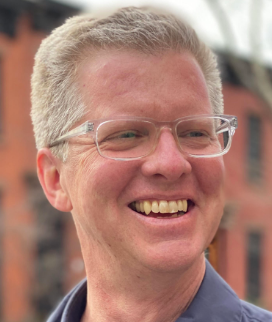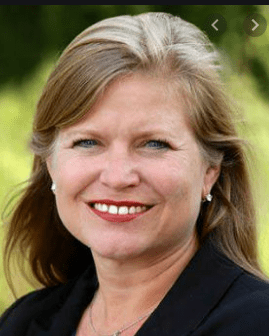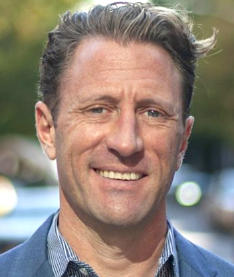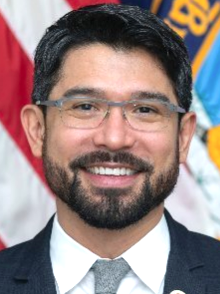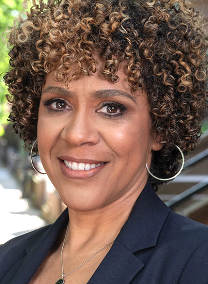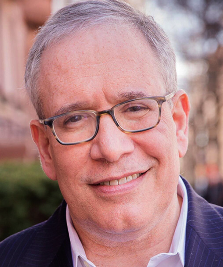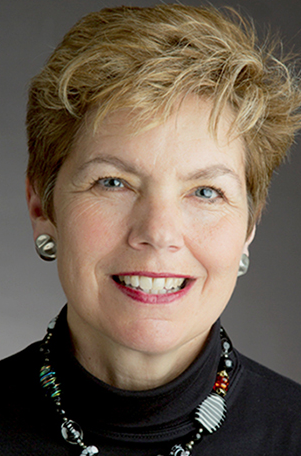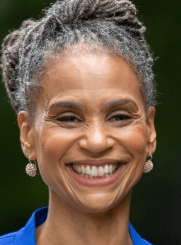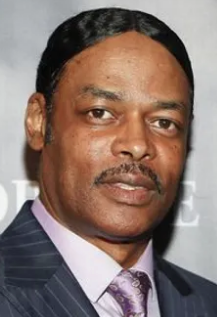DECISION 2021: How Should the Next Mayor Rein In the NYPD?
12:26 AM EST on December 21, 2020
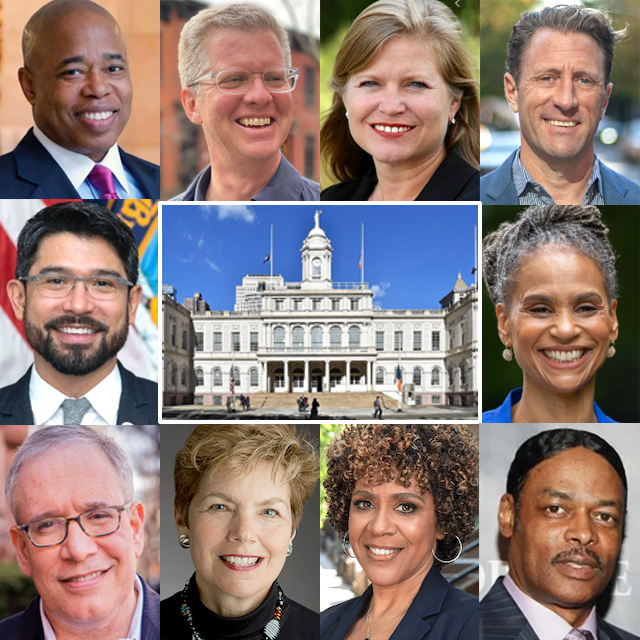
The mayoral candidates pictured with the building of their dreams.

The NYPD acquitted itself badly during the Black Lives Matter protests of last summer, beating protesters (often with Trek bikes) and barricading precincts all over the city behind metal barriers that choked off streets and sidewalks. (Many barricaded precincts persist in this assault on New Yorkers' mobility — months after the end of the protests.) This, after years of officers' racial biases in traffic, bike and even "jaywalking" enforcement — not to mention reckless driving by officers, as Streetsblog chronicled in an investigative series.
As part of our mayoral candidate questionnaire, we asked 11 Democratic hopefuls (all but Ray McGuire responded) what they'd do to rein in a rogue force that too often has run riot under Mayor de Blasio — and got back some frank answers.
"The reality is that the mayor lost control of the NYPD, plain and simple," said one, Kathryn Garcia, who until recently was de Blasio's sanitation commissioner.
This is the sixth of daily rollouts of the candidates’ thoughtful and often-voluminous answers, which should provide safe-streets activists with a roadmap of where the hopefuls stand on our issues (the earlier five installments focused on safe streets, “free” parking, a car-free Manhattan, their records on stopping reckless drivers and a pledge to forsake money from fossil-fuel interests.) At the end of the series, we’ll post all seven installments in one place for easy reference.
Here was how we put our question:
The NYPD has come under fire for its approach to policing public space, in terms of arresting protesters, exhibiting a racial bias in car and bike stops, and even arresting sellers of churros in the subway. How would you reform the agency’s approach to transportation enforcement? Would you remove the NYPD’s role in traffic enforcement, for example?
Here is what they said:
ERIC ADAMS: As I said to Reclaim Magazine in Nov. 2016, “You can’t take the police out of Vision Zero, you can’t take the public out of Vision Zero.”
From my experience as a former police officer, I know that traffic stops are among the most dangerous and unpredictable encounters one can face.
I also know, whether it is traffic enforcement or any other act in policing, that there can and must be greater precinct-level accountability from integrity control officers who are more empowered and publicly visible, something I have advocated for as borough president.
I also believe we can civilianize roles in the NYPD, such as the Collision Investigation Squad and the issuing of summonses that do not involve person-to-person interaction, where conflict is possible.
SHAUN DONOVAN: The NYPD’s approach to transportation enforcement needs dramatic reform as we reimagine the role the city must play to advance safe and widespread use of transportation alternatives. I read Streetsblog and I am sickened by the steady stream of stories reporting motor-vehicle crashes causing pedestrian and cyclist deaths.
Out of respect for the families involved and in an effort to make our streets safe for all users, we need consistent, predictable, meaningful enforcement against unsafe drivers. First, it goes without saying that the city’s infrastructure must be improved to ensure bicycle and pedestrian safety — through more protected bike lanes, expanded use of pedestrian plazas and open streets, and redesigning of dangerous pedestrian crossings.
However, even with such changes, the NYPD must recalibrate traffic enforcement efforts to demonstrate our city's commitment to serving the vast majority of New Yorkers who do not own motor vehicles and primarily move around the city by foot, bicycle or public transportation.
As a preliminary matter, the NYPD's current enforcement of traffic laws too often appears reactionary and arbitrary in a manner that undermines confidence in police and fundamentally fails to protect New Yorkers and municipal workers. This can be seen in relation to the NYPD's response to traffic fatalities and injuries; which primarily are the result of motor vehicle negligence threatening cyclists and pedestrians alike. For example, following bicycle fatalities, local precinct responses have often focused on increased patrol presence around the site of the fatality, with officers issuing summons to cyclists for perceived dangerous behavior.
At the same time, NYPD and local prosecutors have too often failed to investigate, arrest and prosecute reckless or negligent drivers who cause cyclist and pedestrian deaths. This two-fold failure reflects a misguided approach that attempts to alter cyclist behavior through heavy handed enforcement, while abdicating responsibility to punish and correct dangerous driving which is more often than not the true cause of pedestrian and cyclist deaths.
Here, appropriate enforcement would be targeted at alleviating the dangers that precipitate cyclist and pedestrian deaths — insufficient enforcement of vehicles blocking bike lanes, distracted driving and speeding, and the all-too-common instances where vehicles fail to yield to pedestrians or bicycles with fatal consequences.
The NYPD also must internally address issues related to precincts that disrespect the communities they serve by usurping public space for private use or officers failing to follow rules of the road while on or off-duty. First, the current mayor and police commissioner have failed to adequately address the overarching issue of placard abuse that too often results in police officers facing no repercussions for illegally parking private vehicles on sidewalks, in crosswalks, or playgrounds and parks.
Even in their official capacity, too often police vehicles are found parked in bike lanes or precincts that have fortified surrounding public sidewalks and streets and limit public access on the pretext of protecting police property against perceived threats of protest violence. Ultimately, this conduct places police above the communities they serve, and often result in dangerous conditions for pedestrians and bicyclists.
As mayor, I'd work to hold precinct leadership accountable for misconduct by officers under their command — quite simply, officer behavior that threatens public safety or displays disrespect for the communities they serve, must be corrected and if not, leadership must be replaced.
Finally, as mayor I will facilitate a wholesale evaluation of the policing within our city in hopes of identifying circumstances where truly dangerous conditions exist that warrant the response of armed police officers. At first glance, certain areas of traffic enforcement appear ripe for removal of NYPD presence such as crowd control — either in the context of monitoring protests, parades or protecting Open Streets — street-vendor enforcement, or run-of-the-mill vehicle stops.
In September, I visited an open street in Allerton, the Bronx, and saw police barricades and patrol officers used to block the street from cars. This type of police presence is costly and unnecessary, as officers serve roles that could very easily be placed in the hands of community members or other civilians. Ultimately, we must have honest dialogue between elected officials, law enforcement, and members of the public about how to develop community-informed enforcement strategies, and collective decision-making regarding the use of public space, that will keep New Yorkers safe while building mutual respect between police and the communities they serve.
KATHRYN GARCIA: The reality is that the mayor lost control of the NYPD, plain and simple — and we haven’t taken clear and obvious actions to protect lives. I’m the only candidate with experience of managing a uniform agency, and I know what it takes to create a culture of accountability.
In my administration, we will require city residency for new cops, increase the recruitment age from 21 to 25, increase community policing, and require implicit bias training.
We will also change policing by embedding qualified civilians that can help address non-violent situations, focusing on mental health and domestic violence. I have overseen an agency that has uniformed personnel working closely with civilian personnel — and it makes each side stronger.
ZACH ISCOL: I want to be clear and separate moving-vehicle violations, which are under the purview of the NYPD, from parking violations, which fall under traffic enforcement agents and not police officers. As mayor I would take a number of actions that have been laid out in Transportation Alternatives’ paper “The Case for Self-Enforcing Streets.”
A move toward automated traffic enforcement will remove the potential for racial bias and also allow for around the clock enforcement. Protected bike lanes are not only safer for cyclists but also pedestrians, and have been shown to reduce cycling on the sidewalk by as much as 94 percent. As recently as 2018-2019, 86.4 percent of tickets issued for biking on the sidewalk were to Black and Latino New Yorkers, illustrating both of the dynamics above: poorly designed streets and inequitable enforcement.
As far as public spaces, public transit, and the way that the unhoused are currently policed I would propose a new multi-agency task force, similar to the Crisis Management System that the city introduced in 2014, to address these problems proactively, not reactively. We need to break down existing silos between city agencies so that the NYPD is not forced to respond to problems that would be better handled by social workers, mental-health specialists, and others.
I laid out this problem in a recent Daily News article. I don’t think it is right to blame police officers for arresting someone for selling churros, without condemning the broken system that makes it cost $25,000 for a vendor to get a license to sell them. I would work with the Street Vendor Project to support our vendors and provide pathways to allowing vending in a way which is also respectful to the needs of New Yorkers including residents and businesses.
On the other hand, parking violations have not been well-managed and we are not ticketing enough when vehicles display phony placards and paraphernalia, park illegally and on sidewalks. The local NYPD precincts often have difficulty in addressing these issues with traffic enforcement and it takes resources to divert NYPD officers to ticket in these instances. Bringing this enforcement entirely out from under the NYPD as I mentioned above would be the most equitable solution.
For this reason, I wish I could say that I have done more. This is why I am calling for re-working our traffic enforcement, to ensure we hold reckless drivers accountable and create safe street infrastructure that doesn’t leave pedestrians and cyclists at the mercy of drivers.
RAY McGUIRE: Did not answer.
CARLOS MENCHACA: Simply put, we need to reduce policing in our communities overall and that is especially clear in public spaces and transit spaces.
Removing traffic enforcement from NYPD is one move but overall we must create non-police solutions.
I see one of our biggest problems is cars blocking buses, which are primarily used by working people and the elderly to get around in the city.
As mayor, I would dedicate a significant part of the budget to building exclusive bus lanes where there would be no room for individual drivers to block a bus lane, removing the NYPD from the equation.
DIANNE MORALES: We need to massively divest from the NYPD and invest in our communities.
Too often traffic stops for moving violations are the auspice for racial profiling, which leads to criminalization and violence against Black and Brown people.
Previously, the city housed parking enforcement outside of the police department. These are unarmed, civil servants who keep driver’s from abusing their privilege to leave their cars on our streets.
We could have a civil-service corps with a similar strategy to enforcing moving violations, with a focus on overall safety, instead of the criminalization of community members.
SCOTT STRINGER: I believe we should substantially reduce or eliminate the role of armed officers in traffic enforcement. But that’s only part of the solution.
A well-designed street can reduce speeding, crashes, and the blocking of bus and bike lanes. To the greatest extent possible, let’s make our streets self-enforcing.
We should also ramp up camera enforcement to reduce speeding, the running of red lights, blocked bus lanes, and blocked bike lanes. These cameras should be equitably distributed and coupled with legislation that targets repeat offenders.
Finally, I will work with state legislators to decriminalize jaywalking, chalking, biking on the sidewalk, and a number of other minor offenses that have been used to arrest protesters and criminalize communities of color.
LOREE SUTTON: I have developed a “3R” strategic framework for reimagining modern policing, reinvesting in communities and police officers as partners in public safety and rebuilding trust through collaboration and common cause with communities and cops alike.
Short of removing NYPD’s role in traffic enforcement, I would first establish an inclusive process embracing the perspectives of all stakeholders, including NYPD to review the current data and identify patterns and trends ripe for intervention as well as to listen to and learn from individual, neighborhood and advocacy groups — aimed at achieving constructive solutions through collaboration where there’s consensus and commitment to forward progress dispute disagreements.
I would also ensure we had a process of evaluating the disparities in determining arrests and infractions resulting in arrests. I want to make sure our prosecutors are given the correct direction on when it is appropriate to prosecute and when they should be diverting to drug courts, mental health courts, veterans courts or community courts for restorative justice. There are several pilot programs in the city for community courts — where the community is given a role.
This gets back to my inclusive process for bringing together all the stakeholders — elected officials, law enforcement, philanthropic sector, private sector, non-profit sector — to reimagine policing in a modern city like NYC; reinvest in the social determinants of community health and safety; and to rebuild trust between cops and the communities they serve.
Using this approach, we would move from a pure enforcement mentality that measures success on numbers of arrests, to a problem-solving mentality of resourcefulness, community engagement, de-escalation and problem solving.
MAYA WILEY: There is a clear racial bias in car and bike stops.
As evidenced by your analysis, 86.4 percent of tickets for biking on the sidewalk were given to Black and Latinx New Yorkers.
There needs to be a significant reorientation in the way police interact with the public, including clear mayoral oversight of the policies and priorities of policing that will reduce biased interactions like biking and sidewalk tickets.
I would explore removing the NYPD’s involvement from routine traffic enforcement and oversight and transferring it to more appropriate city agencies, such as the Department of Transportation.
ISAAC WRIGHT, Jr.: As it relates to the NYPD, the first step is having leadership that reflects the diversity of the city.
As it relates to police reform, cops and members of the community agree; our system is severely broken. With my personal history (editor's note: Wright formerly was unjustly incarcerated), I’m uniquely positioned to bridge the gap between police and the community they service.
Those adjustments at the top, ensuring the leadership is reflective of the community they protect and serve, will have an immediate impact on the departments approach to policing public space.
Also, I love churros. That’s not exactly pertinent to the question on hand, but I’d like to go on record with that. This is a pro-churro campaign.
Read More:
Stay in touch
Sign up for our free newsletter
More from Streetsblog New York City
Thursday’s Headlines: Speed-Limiting Tech Edition
State Sen. Andrew Gounardes continues his push to force reckless drivers to install speed limiters in their cars. Plus more news.
DOT Official: All Our Free Parking Justifies Keeping Curb Space for EVs
If only someone could do something about the parking!
New York City to Install 500 Secure Bike Parking Hubs In The Next Five Years: Sources
Your bike may finally get a roof over its head.
Adams Backs Lower Speed Limits, Calls Crashes ‘Accidents’
The mayor wants New York City drivers to "slow down," but it's not clear yet how many streets will get lower speed limits.
Wednesday’s Headlines: Trump Posts About Congestion Pricing Edition
Donald Trump comments on congestion pricing — no surprise, he's against it. Plus more news.

